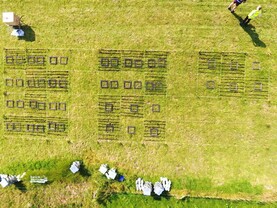Ploughing grassland has received some bad press lately, due to the release of carbon from the soil. However, new research that Teagasc was involved in examined the effect of deep ploughing grassland on soil carbon sequestration with positive results.
The project examined sites in Ireland, Germany and New Zealand.
Teagasc has stated that ploughing to 40cm (16 inches) results in carbon-rich top soil being deposited to the lower levels of the soil, which protects the carbon stocks.
Dr Dominika Krol, a researcher at Teagasc Johnstown Castle, commented that these carbon stocks are effectively buried to where the soil biology is not as active and so carbon is not released at the soil surface.
She added: "Simultaneously, the soil from lower layers is brought to the top. This soil is typically characterised by lower carbon content and therefore has larger capacity to absorb new carbon taken from the atmosphere during photosynthesis by the grassland sward, building up soil organic carbon stocks and improving sequestration."
This soil is typically characterised by lower carbon content and therefore has larger capacity to absorb new carbon taken from the atmosphere during photosynthesis
However, many will wonder if burying the soil high in organic matter would impact on crop yields and performance.
Dr David Wall of Teagasc explained how a carbon tracer was used to examine the effect of tillage method on soil carbon and biomass yield after a new crop was planted.
Minimum tillage, conventional tillage and deep ploughing were examined on species-rich swards, monoculture ryegrass swards and multispecies swards as part of the research.
The deep tillage method was found to successfully bury the carbon-rich soil. Carbon content in the top 10cm of soil did not change very much after ploughing, but carbon can take a long time to build up.
Prof Gary Lanigan noted that one year after reseeding, the swards established using deep ploughing were performing better than those that had not been reseeded at all.
"The use of carbon tracers revealed significant differences in net ecosystem productivity between the different tillage methods and sward types."
Within one year of deep ploughing, the grass production responded positively and was significantly greater than the non-renovated pasture
"Significantly lower grass biomass production was shown after conventional tillage compared to minimum and deep tillage methods. Grassland productivity was reduced shortly post-renovation. However, within one year of deep ploughing, the grass production responded positively and was significantly greater than the non-renovated pasture."
This work is ongoing at Teagasc and a lot more can be gained from these field trials. However, early conclusions are that deep ploughing to 40cm can help to increase carbon sequestration without any long-term adverse effects on grassland productivity.
According to Teagasc, with 2% of grassland soils being reseeded each year in Ireland, this could result in an increase of 1t/ha of carbon sequestration, which would offset 1.4% of annual greenhouse gas emissions from agriculture.
Implementation on farm
As more research becomes available, it will be essential to give proper guidance to farmers on ploughing techniques.
For example, if ploughing to a depth of 40cm, the width of the sod needs to be wide enough to ensure that the soil rich in carbon is buried to the appropriate depth.
Skimmers will also play a crucial role in ensuring that the top layer of soil is buried.
It should also be noted that in many parts of the country, it is not practical or possible to plough to a depth of 40cm, so this will not be possible on all farms.
Farmers will also need to make sure they work on increasing soil biological activity and, as is standard when reseeding, have the correct soil pH.






 This is a subscriber-only article
This is a subscriber-only article










SHARING OPTIONS: